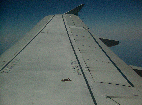 Standing Shock Photos
Standing Shock Photos Standing Shock Photos
Standing Shock PhotosAll these were taken with a digital camera from the window by my seat on some trips in spring 1999. The aircraft were at cruising altitude and speed (which I didn't note, but should have been in the mid-thirty thousands of feet of altitude; speed should have been near the nominal cruising speeds for the aircraft in question, as we were not late or trying to make up time, nor was there any unusual weather.) Some of the shadows and such on the pictures are artifacts from the lack of clarity on the windows, but I'm quite sure that the lines I describe below were the shadows of the shocks - they all moved every time the wings flexed.
The sun was fairly high in the sky on both occasions, and shining on the wing from the south each time (so it was close to directly abeam of the aircraft), both of which I believe helped create stronger than average shadows of the shocks.
Flying westbound, port wing (facing south). Red arrows were edited into the photos to help point out the shocks.
Flying eastbound, starboard wing (facing south). There are no arrows in these, since the shocks are quite visible.
Anne's Other Random Stuff page is sort of "up" from here...
Date last modified: 1999-Sep-27
Copyright 1999 Anne R. LaVin
This page's URL: http://web.mit.edu/lavin/www/shockwaves/index.html